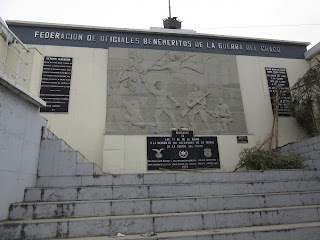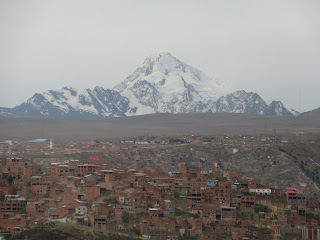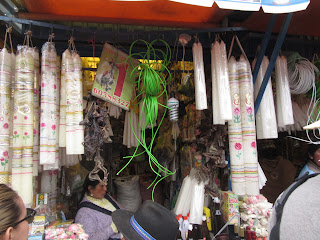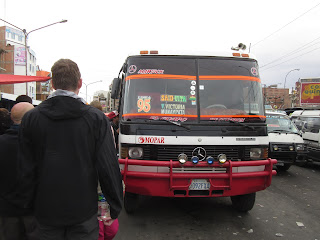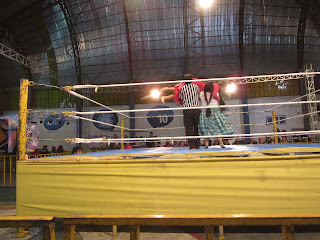Earlier in the day, our walking tour of La Paz had taken us
through the Witches’ Market and Danny,
our tour guide, had talked at length of his president’s foibles and
accomplishments. We opted to join him for the extended tour of La Paz that
started at 2:45 with a ride on a city bus. I’m sure you’re thinking that
couldn’t be worth mentioning, right? However, this was La Paz and not a major
US city where the buses normally run like clockwork.
Danny mentioned that the
buses were run by the unions or a syndicate and operate like taxis with no set
routes. As you can imagine, it’s all very chaotic as the driver can choose if
he’s going to stop and take certain passengers. We had to wait for several
buses until Danny was able to convince the driver to take our fairly large
group to La Paz Cemetery, our first stop.
In La Paz, people have to be more afraid of police than of
criminals, according to Danny. It was more than a little alarming to learn that
fake police officers and bogus tourist officials exist in Bolivia’s
administrative capital. We were warned that we should refuse to show impostors
our valuables and insist on going to the nearest police station on foot. That
all sounded well and good but how were we to know if a police officer were an
impostor or the real deal, so to speak? Luckily, we never needed to find out!
As the bus drove along a street selling clothes for
cholitas (more on them below), Danny explained the whole city is like one big market. The city was
a shoppers’ paradise; not only were the prices very reasonable but the quality
of what was offered was amazing. I had already been wowed by the street outside
our hotel that was full of artisans’ stores with wonderful woodcarvings, ceramics and
lovely textiles, wall hangings and woven belts and pouches.
In 1831, Danny told us that people could buy a plot of land
in the La Paz Cemetery for their
entire family. Too soon, space ran out and, as in most Latin American
cemeteries, bodies are first buried in the traditional Western way or are
placed in a crypt. Then, within ten years, they are disinterred and cremated.
After cremation, families purchase or rent glass-fronted spaces in the cemetery walls for the ashes. They place plaques and mementos of the deceased and flowers behind the glass doors. Each wall had hundreds of these doors, and some of the walls
have been expanded upward to such an extent that they resembled three or
four-story apartment blocks. As a result, the only legal public cemetery in the
city was an active place with people passing through to visit relatives and
leave or water fresh flowers.
Danny said family members must pay cemetery fees for their loved one for five years. After that, they often ‘forget’ about them, i.e. they don’t want to pay more fees. The cemetery then removes the bodies but keeps the skulls or ñatitas so they can be adopted by others because locals believe having a skull in the home protects the family from robbers. Every year in early November Bolivians crowd local cemeteries to display the skulls they keep at home, to have the beloved craniums blessed.
Part of a centuries-old tradition, many here believe they represent the souls of the dearly departed. If treated kindly and with respect, the skulls will protect families and businesses, and grant wealth and a healthy life. Keeping a ñatita in one’s home can provide security for the home, ensure domestic tranquility, aid students in their schoolwork, and provide sage advice. Danny mentioned that sixty percent of people have a ñatita in their homes.
This large wall honored the war heroes in Bolivia’s war against
Paraguay from 1952-1955.
Kids were regularly hired to clean out graves as they were small and
thus able to get in the graves more easily. Even though that came to be considered as child
labor, children could continue to do it ‘if they wanted.’
The murals at the end of each aisle related to spiritual beliefs and were painted by
street artists and redone every year for All Saints Day that had just been marked on November 1st.
There was lots of nudity expressed in this mural because one’s
soul was going up to the angels.
Some of the heads were cone-shaped to reflect what happened during a specific ceremony from the ancient Tiwanaku culture. You'll read more on Tiwanaku in my upcoming post from 11/10.
Some of the graves were extremely simple while other granite
and bronze ones were clearly more expensive.
Sometimes, there were treats in the crypt because the dead
were still considered to be among the families for their first five years post mortem.
The cemetery had placed an eviction notice on this grave.
This grave belonged to the writer of the country’s national
anthem, Gilberto Rojas.
It was hard to fathom there were upwards of 200,000 graves
in the mammoth and fascinating La Paz cemetery!
The rear of the cemetery led directly to Mi Teleférico, the aerial cable car system designed by an Austrian company in 2014. The system’s red, yellow and green lines, representing the colors of the country’s flag, combined at ten kilometers long to make the world’s longest aerial cable car system. For the first time, people could easily and cheaply travel from the poorer areas in El Alto high atop the city to the canyons far below inhabited by the richer people. The cost of each fare was half subsidized by the government.
Evo Morales, the city’s president,
literally put his face on the project by making sure his face was plastered on each car!
‘The thrill of riding above La Paz’s swirling traffic and deep
canyons was undeniably cool’ as written in Lonely Planet.
The system was eco-friendly as it was powered by solar panels on top of each car. The red line was the oldest line.
The view of the huge city once we reached the top was interesting as it just seemed to go on forever.
There would not be problems in La Paz with running out of water unlike in Cape Town as the city got its water from the snow-capped mountains that were part of the Andes and overlooked the city.
The reason for the cable car ride was Danny wanted to escort
us through the Mercado Negro, the
largest flea market in South America, that was accessible via the red line and
located in El Alto. The market was known to be particularly cheap as migrants move
to this area upon arriving in La Paz. The Black Market was also called the ‘Big
Bad Market’ in Aymara, the language used by the indigenous people, according to
Danny.
He warned us not to stop for anything while following him through the market as vendors would do anything to divert our attention, even going so far as throwing fake babies in our direction, so we could be pick pocketed more easily! We love our annual overseas ‘adventures’ and being exposed to new cultures but this was scary.
There were different sections for toys, clothes, food, etc. in the forty blocks that comprised Mercado Negro. Animals were also available for sale though it was illegal to buy or sell them.
The Market was a feast for all our senses as I hope these pictures show.
Haircuts were available on Thursdays or Sundays only at the
low price of six to eight Bolivianos, about $1. The only catch was the
hairdresser would cut everything off!
The shoe shiners belonged to the Aymara culture and make
sure to hide their faces so they’re not recognized by friends in their culture
as one's feet were considered most important. The shoe shiners write a weekly
paper about life on the street.
Danny next took us along an entire street near the market that was full of witches.
Locals consulted them when they needed
to make an important decision. He said the knowledge the witches have is passed down
from generation to generation. The highest or most powerful witches were known
as Amanta
as they had survived being struck by lightning twice! There are very few of
them because it is obviously so rare to be struck by lightning twice.
Signs outside the witches' stalls or kiosks advertised what they could treat and their specialties. Notice the image of coca leaves in the second photo.
Danny revealed that Morales, the country’s first indigenous
president, has an Amanta working for
the government and to advise him.
Underneath the Catholic monument was a sacred stone favored
by the indigenous people. The Spanish conquerors built a Catholic church or
monument on top of every sacred stone to catholicize the indigenous people. Tupukawari, an indigenous chief, fought
against the Spaniards. When he died, his heart was buried next to him.
Danny asked if any of us wanted to have our fortunes told
by one of the witches. Another woman and I said yes when no one else expressed
any interest or didn’t want to pay the nominal fee. After the other woman was finished, Danny and I entered the witch’s tiny cubicle so Danny could translate my limit of three questions and repeat the answers to me. I hadn’t realized that I was supposed to have thought of three questions ahead of time before entering so I was caught off guard.
Danny explained the questions had to have yes or no answers, number answers or option one versus option two responses.
When I asked each of my questions, one at a time, the witch put coca leaves on a small cloth in front of him, covered it up, chewed some coca leaves, said a short prayer over the leaves and then moved the leaves around with his hands.
He then slowly opened a corner of the cloth before unveiling it entirely to look at the shape of the leaves and their location on the cloth. That 'information' gave him the answers to my question each time.
The witch equivocated a bit with my first question but, with
both the second and third ones, he was adamant right off the bat! It was an experience I will never have again and, because of that
alone, was a special time! Do I believe in what he said, you may ask? Well,
time will tell is all I will say!
More scenes we weren't likely to see anywhere else!
The day’s last and perhaps the most anticipated activity was
attending an evening of America’s WWF-inspired and MMA-sanctioned wrestling matches fought or performed by
the Flying Cholitas. Danny essentially had to hire one of the local buses as you
would a taxi to take us to the arena that looked like an old airplane hangar
which was possible given the location of the city’s airport nearby in El Alto. This was
another time that, while planning the 3.5 month-long trip, we had made sure to
be in La Paz that specific evening so we could attend the match.
When the bus seemed to take forever to reach the arena because of the city’s horrendous traffic, I remember being anxious that we would miss a good chunk of the entertainment as it was supposed to have started well before we finally arrived at 6:45. I didn’t realize that Danny had called ahead and asked them to delay the start of the Cholitas’ wrestling.
"Once a derogatory term for indigenous or mixed heritage girls, the word 'Cholita' has come to have positive connotations as a name for the empowered, fashion-conscious, resourceful and proud women of Bolivia. For the first time, indigenous Aymara women are owning the word Cholita, using their iconic dress and feisty spirit to rise above the racism and oppression that has plagued them. One area in which Bolivian women are making waves is in the popular Latin American sport known as Lucha Libre."
Since the 1950’s, Bolivian wrestling has been a popular sport in the country. However, it wasn’t until 12 years ago that Cholita wrestling was really pushed into the spotlight. Cholita wrestling was first started as a way for females who suffered from domestic abuse to express their frustration and release stress. It wasn’t until local wrestler and promoter Juan Mamani had the idea to put the women into the wrestling ring for publicity, that the money-making opportunity became apparent.
Cholita wrestlers had been part of Mamani’s Titans of the Ring, which included male and female wrestlers. However in 2011 many of the Cholitas decided to break away from the male-controlled Titans and set up their own association as The Fighting Cholitas. The female wrestlers perform twice weekly for an audience of hundreds in El Alto and several hundred spectators when they travel with the Titans to smaller towns.
The men’s wrestling was the warm-up act for the female
wrestlers. Johnny, the one in green below and one of the Masked Marauders, won after there were cries for him to
finish his competitor off, finish him off!
Like the general population of El Alto, which consists almost entirely of Aymara and Quechua residents, the Cholitas are indigenous. They wear braided hair, bowler hats and multilayered skirts in the ring.
The Fighting Cholitas were featured in an October 2008 episode of my favorite reality series, The Amazing Race, in which a contestant from each team was tasked with learning and performing a six-step wrestling routine with a Cholita. Suellen: Do you remember watching that episode?
Over recent years, Cholita wrestling has become popular with both locals and tourists alike, the women captivating crowds with their colorful costumes and enthusiastic antics. It was no secret that the staged shows focused more on entertainment than skill.
I learned that more than entertainment and profits, Cholita wrestling is a way for Bolivian women to prove their worth in a 'man’s world.' Having been abused, humiliated and discriminated against throughout history, the ring is one place where indigenous women can hold their heads high, do their job with pride, and be on equal footing with men.
Another way in which Cholita wrestling is empowering women is by providing the female working-class with an opportunity to earn money. Most Cholitas come from low-economic and/or broken households and wrestling is a way for them to independently improve their own life and that of their families.
According to a 2005 New York Times article, the Titans then earned about $13 for each bout which lasted about ten minutes. Most of the wrestlers have other jobs besides their wrestling careers.
The ref’s antics clearly rallied the crowd comprised of many
locals and very energized tourists!
The two ringside commentators added much drama throughout the evening's entertainment.
A couple of minutes later, another bout began with another Cholita entering the area outside the ring to garner the crowd's support.
Her entourage!
The competitor then entered to great fanfare and hoots and hollers!
The cholitas looked as if they had trained in gymnastics as
some of their moves were very acrobatic.
In the third bout, the ref clearly favored one of the
cholitas and began kicking and punching Sonya, the ‘opponent’ dressed in pink.
Sonya soon became the crowd favorite as the underdog, especially when she
bounced the ref out of the ring!
It was camp, it was cheesy, it was hugely entertaining but I
had difficulty with the male refs repeatedly hitting and kicking one of the female wrestlers in each bout. The
physical violence and battery, whether it was real or imagined, was still very
disturbing particularly in the name of entertainment.
La Paz at night:
We got dropped off at our hotel at ninish after an almost twelve-hour day of sightseeing. We were so thankful that we were able to participate in the second walking tour of the cemetery, a ride on the teleferico, the Black Market and the Cholitas’ Wrestling Match, all sights we’d wanted to see but would have been too difficult to manage on our own given the vast distances between them.
Next post: Tiawankuu Ruins.
Posted on February 28th, 2018, from Littleton, Colorado.








